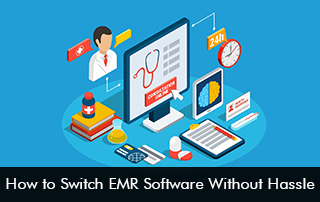Switching EMR software can feel like a daunting task. This is especially true when juggling patient care, administrative duties, and staff training. However, with the right approach, transitioning to a new software can be smooth, efficient, and even rewarding.
This guide goes through the essential steps to switch EMR software without the headaches. From small practice to large healthcare organization, these strategies will help you minimize downtime and maximize efficiency.
Why Switch EMR Software?
Before diving into the how, it’s important to understand the why. Many healthcare providers switch EMR software vendors for several reasons:
1. Outdated Technology
Older systems may lack modern features like cloud access, AI-driven analytics, or telehealth integrations, making workflows inefficient.
2. Poor Usability
If your staff struggles with a clunky interface, productivity suffers. A user-friendly EMR software can drastically improve efficiency.
3. Lack of Customization
Every practice has unique needs. If your current system doesn’t allow customization, switching may be necessary.
4. High EMR Software Costs
Some EMR platforms have hidden fees or expensive upgrades. Moving to a more cost-effective solution can save money long-term.
5. Better Integration Needs
If your EMR software doesn’t integrate well with other tools (e.g., billing, lab systems, or patient portals), a switch may be inevitable.
Step 1: Assess Your Current EMR Software
Before making a move, evaluate your existing system to identify pain points and must-have features in a new EMR software.
Conduct a Workflow Audit
- Map out the healthcare practices’ daily processes.
- Identify bottlenecks that are directly or indirectly caused by the current system.
- Gather feedback from doctors, nurses, and admin staff.
List Must-Have EMR Software Features
- Clinical Documentation – features like specialty-specific templates and voice
- Billing & Revenue Cycle Management – the software should be able to handle the load of billing and invoices of the practice
- Interoperability – features that meet HL7, FHIR standards
- Patient Engagement Tools – robust patient engagement tools like patient portals, appointment reminders, etc.
- Mobile & Cloud Access – Modern needs need modern solutions that encourage connectivity.
Step 2: Research and Compare EMR Software Options
Not all EMR is created equal. Take time to explore different vendors and find the best fit.
Key Factors to Consider
- Specialty-Specific Features
- Ease of Use
- Implementation & Training Support
- Pricing Structure
- Customer Reviews & Reputation
Top EMR Software Choices in 2025
- Epic – EPIC is the gold-standard EHR for healthcare practices, offering seamless integration, powerful analytics, and unmatched efficiency to streamline operations and improve patient care. It’s the smart choice for top-tier performance.
- Cerner – Cerner is a trusted EHR solution, delivering robust interoperability, data-driven insights, and efficient workflows to optimize healthcare delivery. It’s a reliable choice for practices prioritizing innovation and seamless care coordination.
- Athenahealth – Athenahealth is a cloud-based EHR leader, offering intuitive tools for billing, scheduling, and patient care to boost practice efficiency. Its seamless automation and revenue cycle management make it ideal for modern healthcare.
- eClinicalWorks – eClinicalWorks is a versatile EHR solution with strong telehealth, population health, and practice management tools, helping providers deliver efficient, patient-centered care. Its customizable features make it a practical choice for growing practices.
- NextGen Healthcare – NextGen Healthcare combines robust EHR, analytics, and revenue cycle management in a unified platform, empowering practices to enhance productivity and patient care. Its flexibility suits specialty and ambulatory providers seeking scalable growth.
Step 3: Plan the Transition Process
A well-structured migration plan reduces risks and ensures a smooth switch.
Set a Realistic Timeline
- Allow 3-6 months for full implementation.
- Avoid peak seasons (e.g., flu season) to minimize disruption.
Assign a Project Team
- Include IT staff, clinicians, and office managers.
- Designate a project lead to oversee the transition.
EMR Software Data Migration Strategy
- Extract Data Carefully
- Clean Up Records
- Test Data Transfer
Step 4: Train Your Staff Effectively
One of the biggest hurdles in switching EMR software is user adoption. Proper training is key.
Phased Training Approach
- Basic Training
- Advanced Features
- Ongoing Support
Use Multiple Training Methods
- Live Workshops
- Video Tutorials
- Super Users
Step 5: Go Live & Monitor EMR Software Performance
The big day arrives! But the work doesn’t stop after launch.
Run a Parallel System
- Use both old and new EMR systems for a short period to catch errors.
Provide Immediate Support
- Have IT and vendor support on standby.
- Create a feedback loop for staff to report issues.
Track Key Metrics Post-Switch
- User Adoption Rates – Is staff using the system correctly?
- Patient Satisfaction – Are there any delays in care due to the switch?
- Billing Efficiency – Are claims processing smoothly?
Common EMR Software Switch Pitfalls to Avoid
Even with the best planning, mistakes can happen. Here’s what to watch out for:
Rushing the Process – Skipping testing phases leads to errors.
Ignoring Staff Input – If end-users hate the new system, adoption will fail.
Underestimating Data Migration Challenges – Corrupted or incomplete data can cause major issues.
Choosing the Wrong Vendor – A cheap but poorly supported EMR software will cost more in the long run.
Final Thoughts
Switching EMR software doesn’t have to be a nightmare. With careful planning, thorough research, and strong training, your practice can transition smoothly to a better system.
The right EMR platform can improve efficiency, enhance patient care, and even boost revenue, so take the time to make the best choice for your practice.








